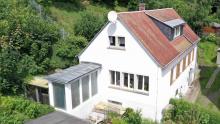
Contact us
Seismological Observatory Berggießhübel
Giesensteiner Straße 8
D-01816 Bad Gottleuba-Berggießhübel
+49 35023 62524
olaf [dot] hellwig [at] geophysik [dot] tu-freiberg [dot] de (olaf[dot]hellwig[at]geophysik[dot]tu-freiberg[dot]de)
Head of Observatory:
Dr Olaf Hellwig
Technical Assistant:
Dipl.- Ing.Ing. Anja Zeibig
Tasks
Since the start of continuous seismic recording in 1966, the Berggießhübel observatory has been one of the base stations of the global seismological monitoring network. Under the station code BRG, national and international data centres are provided with seismological data resulting from a consistent evaluation. This data is used to record and monitor local and global earthquake events and forms the basis for research into the structure of the earth's body. They are also used to monitor compliance with the Nuclear Test Ban Treaty.
Location
The observatory is located in the centre of the small town of Berggießhübel in the Eastern Ore Mountains in the geological border area of the Ore Mountains, Elbe Valley Zone and Elbe Valley Slate Mountains. The measuring devices are installed in measuring chambers 36 metres below the earth's surface in the Hildebrandt tunnel, which was created in the 19th century to explore iron ore deposits. The direct connection to the compact rock and the relatively undisturbed installation conditions provide optimal recording conditions. Due to these conditions, the BRG seismic station registers over 2,000 of the world's earthquakes with magnitudes greater than 4 every year. In addition, there are a large number of earthquakes, explosions and rockfalls at local distances, meaning that the total number of seismic events analysed each year can exceed 10,000.
In addition to routine seismological evaluation, the observatory is involved in the practical training of students at the TU Bergakademie Freiberg in the Bachelor's degree programme Geoinformatics and Geophysics and the Master's degree programme Geophysics. The observatory is also a popular starting point for scientific excursions. The easy accessibility of the station and direct demonstration opportunities for ongoing measurements are well suited to giving visitors interested in geophysics an insight into seismological recording, data evaluation and research.